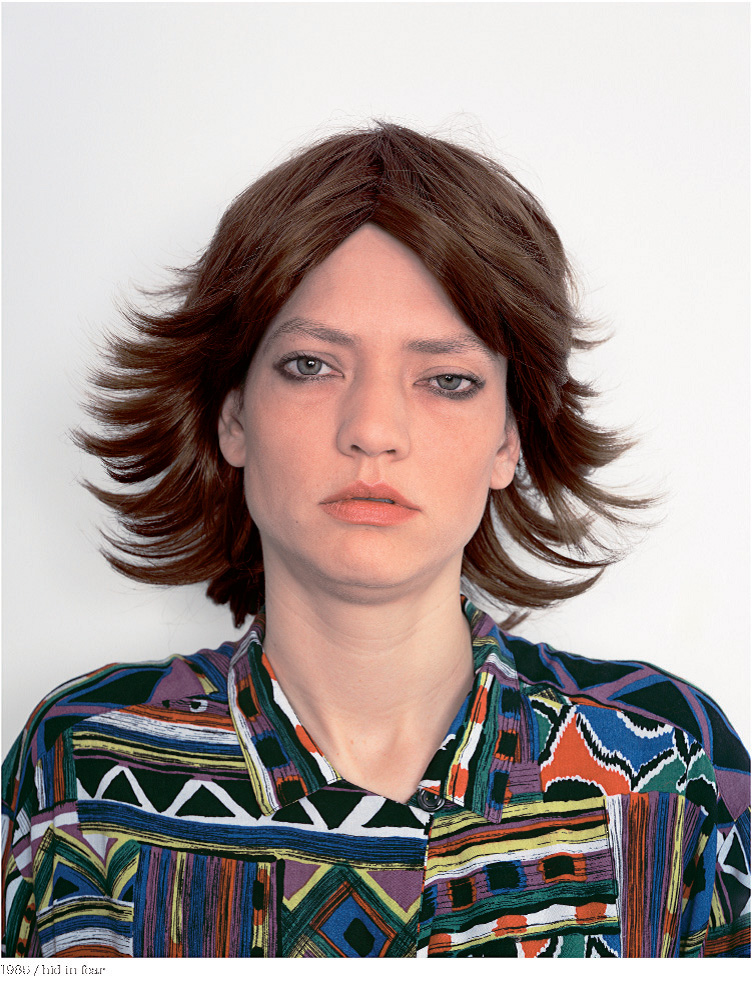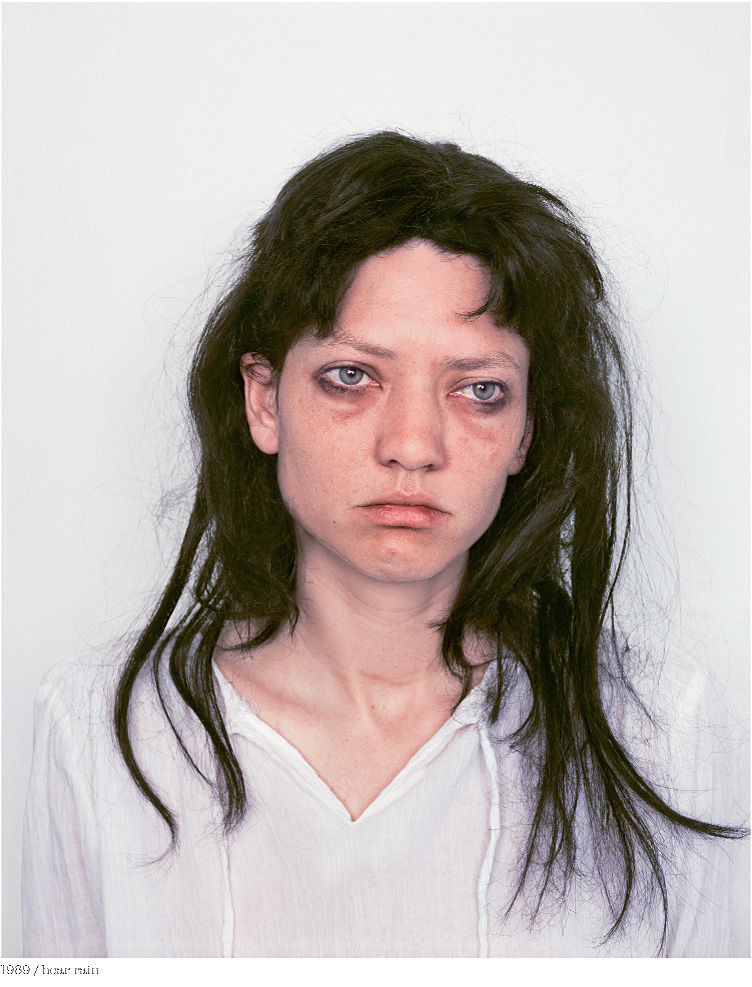E-J major
She is concerned with the complex of biological, social and cultural influences that determine one’s life and shape individual temperament. And it was in fact her parallel studies of photography and social sciences that lead EJ Major to fusing the methods of both disciplines, trying not to distinguish the implications and contexts within the framework of which these different fields operate, and using devices and approaches according to how useful they are for the outcome of her work. And thus EJ Major has gradually developed a method of recycling carefully chosen cultural artifacts. At first they were personal diaries, letters or family photographs, but in the recent years her focus has shifted to the recycling of public cultural products such as films and newspaper articles.
EJ Major therefore uses herself as a filter of otherwise banal media events, of which we daily face an unending avalanche. Magazines, newspapers, television, films, the Internet – all provide information and yet more information, both textual and visual. It is no longer within the realm of normal human capacity to process this assault, for in the proliferation of impulses one no longer knows oneself, the discounted self scattered among a myriad of volatile impressions. This is why EJ Major attempts to recover the lost connection between the detail and the whole, to recapture the broken thread of meanings, to reclaim the original and alienated or almost lost meanings, or rather, she explores whether that is in fact possible. This can be said for instance of her “mail” project entitled Love is… (2004-2006). In this pro-ject, she set as her task the exploration of what this fundamental human emotion meant to ordinary people. She used 7,000 frames from the film Last Tango in Paris, which she printed as postcards and personally delivered to an identical number of randomly chosen addresses around London. The postcards had a return address and asked the random recipients to react to the scene featured on the postcard, and for their contribution on the theme of love. EJ Major picked Last Tango in Paris for this end partly since it is her favorite film, and also because in its day the explicit sexual scenes had caused a scandal, while also provoking debate on the generation gap in the perception of love, and the forms and ways of experiencing love. Around a thousand photographs of the entire number were returned to the artist, who then exhibited them.
The time-lapse process of creating variations on the chosen material, fully dependent on the response and cooperation of strangers, forms the basis of this private investigation. Its result was an unforeseeable and out of control collection of the emotional reactions of viewers, who were presented anew with something they might have been familiar with – and maybe not. Some grasped the connection between the separate image and the original film, while others did not. The film as a whole thus in fact disappeared, becoming merely part of an imaginary framework in a game of associations. Key importance was thus placed on the private and free reaction of the viewer and their experience evoked by either the image torn out of its context, or the theme alone. The key significance of the project as such is the shift in the context of images, which in turn causes a shift of meaning.
Indeed, a shift of context, and a resultant shift in meaning. That is the essential moment that EJ Major follows in her subsequent, and I would say her most fascinating to date, photography project, titled Marie Claire RIP (2004-2005). Here the artist focuses on the exploration of human identity at a time of its utter loss, of its almost irrevocable dissolution, a simultaneously examining an era that almost by definition prevents the healthy development of individual identity in its original sense.
A collection of twelve color prints, Marie Claire RIP tells a story of the loss of identity, or perhaps the impossibility of finding one’s identity; it is a tragic visual illustration of a total alienation and loneliness which ends in a degradation of the person by addictive substance abuse. Marie Claire is not the name of the portrayed girl, but the name of a magazine, which published the original series of her photographs. If one first looks at the twelve portraits without reading the accompanying commentary, one is left with the impression that the girl was photographed over a period of time, during which her mental and physical condition deteriorated sharply. At the beginning, we see a young, smiling, and rather pretty girl, the wild, adventurous kind who plunges fully into everything. The following images capture the rapid and merciless disintegration of personality, as reflected in all outer aspects indicating a person’s condition, the change of expression, or the state of hair, make-up or dress. These faces tell the bleak and uncompromising story of heroin abuse, a substance that first merely affects but soon takes total control of one’s consciousness as well as subconscious, a substance that saps the vital energy of its user with startling speed. Heroin, the instant paradise for the weak and the failed; a momentary paradise that collects high interest from human life.
A shift in perception of this powerful visual series occurs at the moment when the viewer learns that these are in fact not authentic portraits of any real girl. EJ Major is using herself as a model for a reconstruction of magazine-published portraits of a girl who by then was already dead. It was her aim to get as close as possible to the character of the original documentary photographs, and so she spent several months looking for similar clothes, hairstyles and the facial expression in order to imitate as faithfully as possible the original photographs of the addicted girl. Then she photographed the entire series again, with herself cast in the role of the portrayed, and she then scanned and digitally adjusted them so as to precisely restore each individual portrait, down to such details as the structure and color of complexion, or nuances of expression. She then tagged the pictures with the original dates of the source photographs.
The result is a convincing and at the same time extremely sarcastic photographic retelling of an anonymous story of the disintegration of personality, compelling both visually and in terms of the underlying idea. It is stunning how real these portraits are; they are in fact more real than reality, since they amplify reality by generalizing it. They are an unostentatious and at the same time compassionate memento of all those addicted beings who cannot be happy in a natural way, who cannot or do not know how to be happy, which is perhaps what has driven them in search of a chemically-induced paradise, for which they eventually pay with nothing less than their own lives. The anonymous girl from the article in Marie Claire had already paid her loan to the last day and second, but hers is far from an isolated story, – a chilling, hopeless realization. Perhaps this is also because it is increasingly harder to realize oneself.
EJ Major has found a highly original niche in the currently much frequented field of the photographic portrait. For her Marie Clair RIP series is not merely art for art’s sake, a sort of vain self-stylization; its aim and the perfection of its realization bring forth fascinating questions as to the basic credibility of the photographic portrait. It instigates a polemic with the question of authenticity and fiction in this area, rendering the chosen theme with compelling complexity. At the same time, she tackles her own identity, admitting that at certain points she doubted whether it was still herself captured in the photographs, and who in fact was the girl she had brought to life again through these manipulated photographs.
On a more general level, EJ Major’s work deals with drawing a connection between word and image, or, in her own words, an attempt to build bridges between rationalism and emotion. She is concerned with capturing a meaning vibrating somewhere between these two media. She is fascinated to see in what ways these two forms of presentation would assert themselves in the finished work, and how in the space which opens between them there emerge fleeting nuances within the work. Her projects create a catchy tension, which provokes the viewer to further reflection and reaction, always leaving behind a strong impression.
#7 New staged photography
Archive
- #45 hypertension
- #44 empathy
- #43 collecting
- #42 food
- #41 postdigital photography
- #40 earthlings
- #39 delight, pain
- #38 death, when you think about it
- #37 uneven ground
- #36 new utopias
- #35 living with humans
- #34 archaeology of euphoria
- #33 investigation
- #32 Non-work
- #31 Body
- #30 Eye In The Sky
- #29 Contemplation
- #28 Cultura / Natura
- #27 Cars
- #26 Documentary Strategies
- #25 Popular Music
- #24 Seeing Is Believing
- #23 Artificial Worlds
- #22 Image and Text
- #21 On Photography
- #20 Public Art
- #19 Film
- #18 80'
- #17 Amateur Photography
- #16 Photography and Painting
- #15 Prague
- #14 Commerce
- #13 Family
- #12 Reconstruction
- #11 Performance
- #10 Eroticon
- #9 Architecture
- #8 Landscape
- #7 New Staged Photography
- #6 The Recycle Image
- #5 Borders Of Documentary
- #4 Intimacy
- #3 Transforming Of Symbol
- #2 Collective Authorship
- #1 Face











